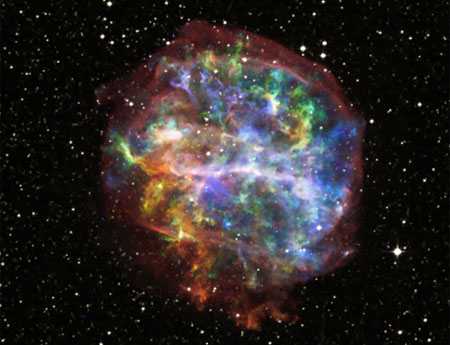Supernovae do not produce the largest element
Although they are bright stars, supernova cannot create the heaviest elements.
The conclusion was made by scientists in a recent study by analyzing the model of 'particle winds' emanating from the core of the supernova.
The work of astronomers from the Max Planck Institute of Astrophysics in Garching (Germany) has come up with a new perspective on supernovae, contributing to explaining the mysteries of formation and generation. development of the universe.

A supernova can produce a neutrino "particle wind" near the speed of light.(Source: NASA)
As we all know, the only two elements that formed right after the Big Bang were hydrogen and helium. The heaviest elements must be formed by melting smaller nuclei together.
The high pressure and temperature inside the stars can help matter particles increase in size but to create elements of greater mass than iron (Fe), in which its nucleus contains 26 protons. Ask for some other important conditions.
In order to fully meet those conditions, only supernovae are available. Burning stars have released neutrinos from the center to their surface at nearly the speed of light, causing protons and neutrons to be strongly impacted and released from the atomic nucleus.
This effect is called the 'particle wind' in which neutrons and protons are melted and create nuclei from small atoms. From there, protons, neutrons and other atoms are constantly involved in this process to form larger atoms.
However, atoms are larger than nickel, with 28 protons, will not receive new protons because at that time, the mutual repulsion of many positively charged particles (+) becomes too strong.
To create atoms, neutrons must penetrate deep into the nucleus and then turn into a proton within the atom, a process known as 'fast neutron capture' or 'r cycle.'
It is the assumption that the scientific world has long been united, that all heavy elements are formed in this way.
Now, Dr. Thomas Janka of the Max Planck Institute of Astrophysics in Garching (Germany) and colleagues think that the composition of the "wind of particles" will create the largest atoms.
Janka's team uses the latest data on energy sources and interactions between protons, neutrons and neutrinos to create a 'mini' supernova model on computers.
With this model, the ability to create large elements depends on the number of neutrons that penetrate the nucleus, so in turn they depend on the number of neutrons not attached to the protons, or called "free neutrons."
Janka's model shows that "wind particles" contain more protons than neutrons. This means there are not enough free neutrons to produce elements that are much larger than iron with nuclei with up to 50 protons.
Instead, Dr. Janka argued that only when a 'neutron-rich' explosion occurred - that is, in terms of how the stars merged together - would it be possible to create the heaviest elements, including gold, lead and uranium.
However, the problem has not really closed there. Researcher Kosuke Sumiyoshi of Numazu National University of Technology (Japan) points out that a large supernova can explode in different ways when its core is different from the "mini" supernova model. of Janka. And because of that, they will create different ratios of protons and neutrons.
However, for his part, Janka and his team hope his miniature supernova model is also true for a larger supernova.
Supernovae, or supernovae, are stellar explosions that make very bright objects mainly composed of plasma that bursts in a short time, the apparent magnitude of the star rising dramatically billions of times, then descending in weeks or months. The total energy output reaches 1044J. Absolute star level can reach -20m.
There are two types of explosions. In the first type, giant stars burn out fusion fuel, lose light pressure, and collapse into the center under their own gravity, until high density and pressure cause an explosion. In the second type, white dwarfs draw material from a star flying around it, until Chandrasekhar mass and fusion boom are achieved. In both types, a large amount of star material is pushed into the surrounding space.
- The chemical is dubbed 'the element of the devil'.
- 4 types of explosions create supernovae
- Confirm the existence of the 117th chemical element
- Learn about supernovae and supernovae
- The carving depicts the oldest description of a supernova
- Blurred meteor detection
- The element has a half-life of 1 billion times the life of the universe
- The Element: Intel's latest weapon to modularize personal computers
- 4 new elements in the periodic table have been named by scientists
- The 28th essential element
- New discovery: Collisions of neutron stars produce heavy elements of strontium
- Unprecedented discovery of supernovae
 Van Allen's belt and evidence that the Apollo 11 mission to the Moon was myth
Van Allen's belt and evidence that the Apollo 11 mission to the Moon was myth The levels of civilization in the universe (Kardashev scale)
The levels of civilization in the universe (Kardashev scale) Today Mars, the sun and the Earth are aligned
Today Mars, the sun and the Earth are aligned The Amazon owner announced a secret plan to build a space base for thousands of people
The Amazon owner announced a secret plan to build a space base for thousands of people